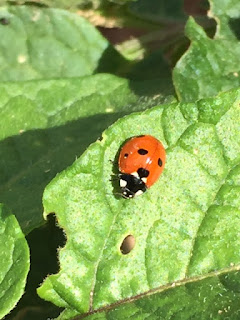My first memory of heirloom tomatoes is helping my maternal grandmother harvest her crop. Granny plucked fruit from her vines and taught me to carefully place colorful orbs in large baskets. We carried baskets down the path from her garden to the backyard where she lifted them to an outdoor concrete table. As Granny filled a huge galvanized tub with water from the faucet and carried it to the table, I climbed to stand on a bench so I could help drop tomatoes in cold well water. Together, we worked, our hands touching underwater, to gently remove dirt. Clean fruit dried on newspaper before Granny took them to the kitchen. Back then, we did not call these garden staples "heirlooms;" they were just tomatoes.
 |
| Some of 2015's Heirloom Tomato Harvest |
When Granny's heirloom bean, sunflower, pea, squash and cucumber seeds, saved for over twenty years, flourished in my garden, it was like having a bit of that special woman return. Although grateful for each inherited heirloom seed, I miss Granny's tomatoes, but, with help from fellow seed savers and online sources, familiar colors and shapes produce abundantly at Heart & Sole Gardens.
 |
| Ripe Chocolate Stripes Tomato |
Perhaps I go a bit overboard when ordering tomato seeds, but glossy catalog photos and descriptions are just too tempting. Along with old favorites like Cherokee Purple, Yellow Pear and German Pink, more exotic species like A. Grappoli D'Iverno and Ciskos Botermo sometimes grow in my tomato garden.
 |
| Tomato Seedling |
Each summer, I save seeds from the most perfect fruit specimens to grow for the following year. After growing over one hundred tomato varieties, I started to notice strange things happening. A few years ago, from the seedling tray I labeled "Sungold," rather than tiny yellow cherry tomatoes I expected, plants produced bright red salad tomatoes. At first, I attributed differences to mistakes I made, incorrect labeling, mixing saved seeds, etc., but then, I began to suspect another reason for garden surprises. Both heirloom and hybrid tomato plants are self-pollinating, meaning blossoms contain both male and female components and do not require pollinators or wind to carry pollen from stamen to ovary. However, if tomatoes are not separated by at least ten feet, it is possible for them to cross pollinate, resulting in seed that will produce fruit the following year that is not true to type.
 |
| The Seed Packet Was Labeled "Blue Beauty" |
Apparently, I am not alone when I inadvertently save cross pollinated seeds; several seed packets purchased from reputable sources also produce surprise plants. Perhaps, due to increased customer demand for heirloom seeds, growers rush to fill orders and fail to test seeds for purity?
A few years ago, I harvested a tomato unlike any fruit I intentionally planted; if it produces the same fruit this year, it is one worth preserving as pure seed. With dark green skin, deep rosy purple flesh, creamy interior stripes and rich flavor, this large slicing tomato produced abundantly throughout last season. Most likely, it is a cross between Chocolate Stripes, Green Velvet and perhaps, Cherokee Purple. I shared seeds and seedlings with several other gardeners this spring, in hopes we can "trial" the plant.
 |
| A Delicious Tomato Surprise |
Most plant specialists define heirloom seeds as those that produce consistently for many generations. If this new tomato remains stable and seed savers are careful to maintain pure seed, perhaps one day the Heart & Sole Tomato may be a true heirloom. For now, I anxiously await the first ripe fruit and hope its flavor in a tomato sandwich will live up to last year's taste memory. Meanwhile, last summer's canned tomatoes are finding their way into many family meals as we clear pantry shelves to make space for what will, hopefully, be a bountiful harvest.
 |
| From Left: Mini Orange, San Marzano, Cream Sausage & Cherokee Purple |
Fingers crossed!
After using canned tomatoes for soup, stew, salsa, casserole, etc., I decided to try something different. This cheesecake is savory and would be a great appetizer for a summer party. Be sure to drain the tomatoes well before adding to the batter.
Heirloom Tomato Cheesecake
For the crust:
1/3 cup each: pine nuts, pecans, slivered almonds, lightly toasted
2 tablespoons butter, melted
Pulse nuts in a food processor about 5-6 times.
In a quart-size plastic zip lock bag, combine nuts and butter, shaking to completely coat nuts with butter.
Spray bottom and sides of 6 inch springform pan with vegetable spray.
Empty bag of nuts/butter into pan and turn bag inside out to press nut mixture into bottom and slightly up sides of pan.
 |
| The Bag's Buttery Inside Makes for Easy Crust Pressing |
Bake crust for 5 minutes in a preheated, 325 degree oven.
For the filling:
Using a stand mixer, beat 3 8-oz packages of cream cheese, softened, with 1 tsp salt and 1 tsp dried basil until fluffy.
Add 4 room-temperature eggs, one at a time and continue to beat until mixture is smooth.
Add 2 cups canned paste tomatoes, drained, and blend well.
Stir in 2 tblsp all-purpose flour until combined.
*For test purposes, I used a cup each: San Marzano (red) and Cream Sausage (white) paste tomatoes.
Pour batter into prepared spring form pan.
Bake cheesecake in preheated, 325 degree oven, for about 1 hour and ten minutes, or until the cake feels set, but still moves to the touch.
 |
| Cheesecake Puffs After Baking, Settles as it Cools |
Allow to cool on wire rack for about an hour and refrigerate overnight.
 |
| Tomato Cheesecake |
To serve, top cheesecake with pepper jelly or pesto and, for a pretty presentation, place on a pedestal serving plate and surround the cake with fresh herbs and edible blossoms.













































